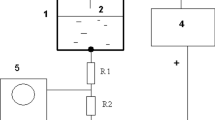Abstract
Ozone, generated by a pulsed power corona discharge, was usedto degrade pentachlorophenol (PCP). The degradation of PCP wasdriven by ozone and superoxide radical (SOR). The coronadischarge reactor was made without glass dielectric material,not only to reduce the power consumption but also to enhancethe formation of the SOR. In addition, the corona dischargedevice was operated with pin-plate or pin-ring typeelectrodes, which had a normal and parallel oxygen flow,respectively. The ozone generated in the corona dischargereactor was in the range of 0-0.39 mg min-1. To confirm the generation of SOR, the hydrogen peroxide was measuredunder acidic conditions without ozone effects. PCP at 10 ppm wascompletely degraded in 10 min in both electrode types withnegative high DC voltage. The degradation rate of PCP was muchgreater at a high frequency (1 kHz). Oxalic, malonic andglyoxylic acids were generated as final products of the reaction.
Similar content being viewed by others
References
Andreozzi, R., Insola, A., Caprio, V. and D'Amore, M. G.: 1991, ‘Ozonation of pyridine in aqueous solution’ Water Research 25, 655.
Arcand, Y., Jalal, H. and Serge, R. G.: 1995, ‘Solubility of pentachlorophenol in aqueous solutions’ Water Research 29, 131-136.
Bruno, L., David, A. R. and Deborah, B. R.: 1991, Ozone in Water Treatment: Application and Engineering, AWWA Research Foundation and Lewis Publishers.
Hargis, L. G.: 1988, Analytical Chemistry-Principles and Techniques, Chapter 6, Prentice Hall, p. 138.
Jiang, Z. Y., James, V. H. and Simon, P. W.: 1992, ‘Ferrous ion oxidation in the presence of xylenol orange for detection of lipid hydroperoxide in low density lipoprotein’Analyt. Biochem. 202, 384.
Kim, J. Y and Moon, S. H.: 2000, ‘A kinetic study on oxidation of pentachlorophenol (PCP) by ozone’ J. Air Waste Manage. Assoc. 50, 555.
Kitayama, J. and Kuzumoto, M.: 1997, ‘Theoretical and experimental study on ozone generation characteristics of an oxygen-fold ozone generator in silent discharge’ J. Physics D Applied Physics. 30, 2453.
Ku, Y., Su, W. J. and Shen, Y. S.: 1996, ‘Decomposition of pehnols in aqueous solution by the UV/O ~3 process’ Ozone Sci. Engineer. 18, 443.
Kuo, C. H. and Charlen, H. H.: 1998, ‘Kinetics of pentachlorophenol in aqueous solution’ Ozone Sci. Engineer. 20, 163.
Petasne, R. G. and Rod, G. Z.: 1987, ‘Fate of superoxide in coastal sea water’ Nature 325, 516.
Rice, R. G.: 1997, ‘Application of ozone for individual wastewater treatment - A review’ Ozone Sci. Engineer. 18, 477.
Robinson, J. A., Maurice, A. B., William, L. C., Peter Castle, G. S. and Ion, I. I.: 1998, ‘A new type of ozone generator using Taylor cones on water surface’ IEEE Transactions on Industry Applications 34, 1218.
Sawyer, D. T. and Morton, J. G.: 1979, ‘The chemistry of superoxide ion’ Tetrahedron 35, 1471.
Tartakovsky, B., Levesque, M. J., Dumortier, R., Beaudet, R. and Guiot, S. R.: 1999, ‘Biodegradation of pentachlorophenol in a continuous anaerobic reactor augmented with desulfitobacterium frappieri PCP-1’ Appl. Environ. Microbiol. 65, 4357.
Tayal, A. K., Linika, D. and Inderjeet, K.: 1999, ‘Biodegradation of pentachlorophenol (PCP) by white rot fungal strains screened from local sources and its estimation by high-performance liquid chromatography’ Biomed. Chromatogr. 13, 220.
Umemura, T., Kai, S., Hasegawa, R., Sai, K., Kurokawa, Y. and Williams, G. M.: 1999, ‘Pentachlorophenol (PCP) produces liver oxidative stress and promotes but does not initiate hepatocarcinogenesis in B6C3F(1) mice’ Carcinogenesis 20, 1115.
Wilson, G. J., Khodadouset, A. P., Suidan, M. T., Brenner, R. C. and Acheson, C. M.: 1998, ‘Anaerobic/Aerobic Biodegradation of Pentachlorophenol using GAC Fluidized Bed Reactors: Optimization of the Empty Bed Contact Time’ International 1998 - IAWQ 19th Biennial International Conference.
Zuo, Y. and Holgne J.: 1992, ‘Formation of hydrogen peroxide and depletion of oxalic acid in atmospheric water by photolysis of iron(III)-oxalato complexes’ Environ. Sci. Technol. 26, 1014.
Author information
Authors and Affiliations
Corresponding author
Rights and permissions
About this article
Cite this article
Hong, KH., Oh, Sj. & Moon, SH. Degradation of Pentachlorophenol by Ozone Generated by a Pulsed Power Corona Discharge. Water, Air, & Soil Pollution 145, 187–203 (2003). https://doi.org/10.1023/A:1023681805283
Issue Date:
DOI: https://doi.org/10.1023/A:1023681805283




